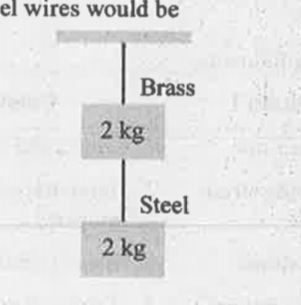If the ratio of diameters,lengths and Young’s modulus of steel and copper wires shown in the figure are p,q and s respectively then the corresponding ratio of increase in their lengths would be
 Solution in Tamil
Solution in Tamil
7q(5sp)
5q(7sp2)
7q(5sp2)
2q5sp
Step by step video & image solution for If the ratio of diameters,lengths and Young’s modulus of steel and copper wires shown in the figure are p,q and s respectively then the corresponding ratio of increase in their lengths would be by Physics experts to help you in doubts & scoring excellent marks in Class 11 exams.
Updated on:21/07/2023Topper's Solved these Questions
Similar Questions
Two satellites of earth, S1 andS2 aremoving inthe same orbit.The mass of S1 is four times the mass of S2. Which oneofthe following statements s true?
View SolutionAssuming the sun to have a spherical outer surface of radiating like a black body at temperature t∘C, the power received by a unit surface,(normal to the incident rays) at a distance R from the centre of the sun is
View SolutionIf the ratio of lengths, radii and Young's moduli of steel and brass wires in the figure are a, b and c respectively then the corresponding ratio of increase in their lengths is
View SolutionWires A and B are connected with blocks P and Q, as shown, the ratio of lengths radii and Young's modulus of wires A and B are r, 2r and 3r respectively (r is a constant). Find the mass of block P if ratio of increase in their corresponding length is (1)/(6r^2) . The mass of the block Q is 3M
View SolutionIf the ratio of lengths, radii and youngs's modulus of steel and and brass wires in figure are 2:1,2:1,3:1 respectively. Then corresponding ratio of increases in their would be. (Neglect the mass of the wire and take g=10m/s2)

View SolutionIf the ratio of lengths, radii and Young's moduli of steel and brass wires in the figure are a,b and c repectively then the corresponding ratio of increase in their lengths is

View SolutionIf the ratio of diameters,lengths and Young's moduli of steel and brass wires shown in the figure are p, q and r respectively . Then the corresponding ratio of increase in their lenghts would be

View SolutionIf the ratio of lengths, radii and young's modulii of steel and brass wires in the figure are a,b and c, respectively. Then, the corresponding ratio of increase in their lengths would be
View SolutionIf the ratio of lengths, radii and Young's modulus of steel and brass wires shown in the figure are a, b and c respectively, the ratio between the increase in lengths of brass and steel wires would be Brass and steel wire would be

View SolutionThe ratios of length areas of cross-section and Young's modulii of steel of that of brass wires shown in the figure are a,b and c respectively . The ratio of increase in the lengths of brass of that of steel wires is [Assume that the masses of steel and brass wires are negligible]
View Solutionयदि चित्र में दर्शाए गए स्टील व पीतल के व्यास, लम्बाई एवं यंग प्रत्यास्थता गुणांक क्रमशः p, q एवं r हैं तो उनकी लम्बाइयों में वृद्धि का संगत अनुपात क्या होगा?

View SolutionIf the ratio of lengths, radii and Young.s modulus of the steel and brass rods in the figure are a, b,c respectively, find the ratio of increase in their lengths ?

View SolutionIf the ratio of diameters,lengths and Young's moduli of steel and brass wires shown in the figure are p, q and r respectively . Then the corresponding ratio of increase in their lenghts would be
View SolutionIf the ratio of diameter, lengths and Young's modulus of steel and brass wires shown in figure are 2 : 1, 2 : 1 and 2 : 1 respectively, then the corresponding ratio of increase in their lengths would be

View SolutionTwo wires P and Q are of the same diameter and having their lengths in the ratio 5:3, when the wires are subjected to the some load, the corresponding extensions are in the ratio 4:3. Compare Young's Modulus of the materials P and Q.
View SolutionIf the ratio of lengths, radii and Young's moduli of steel and brass wires in the figure are a, b and c respectively then the corresponding ratio of increase in their lengths is
View Solution
